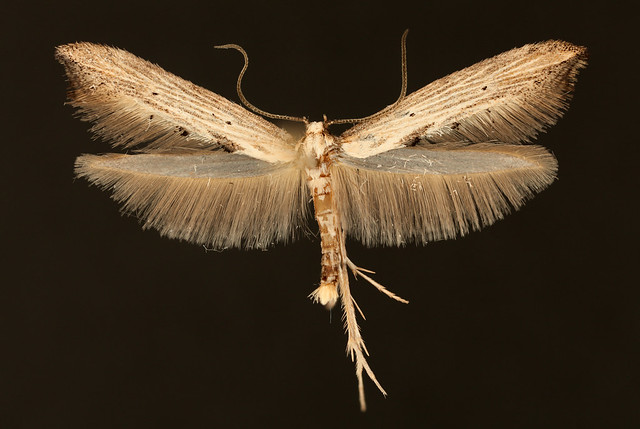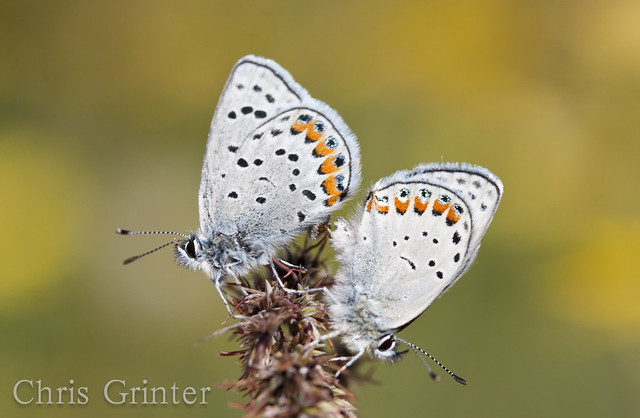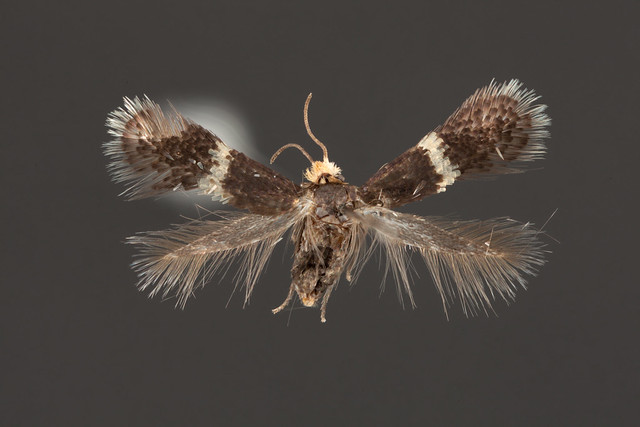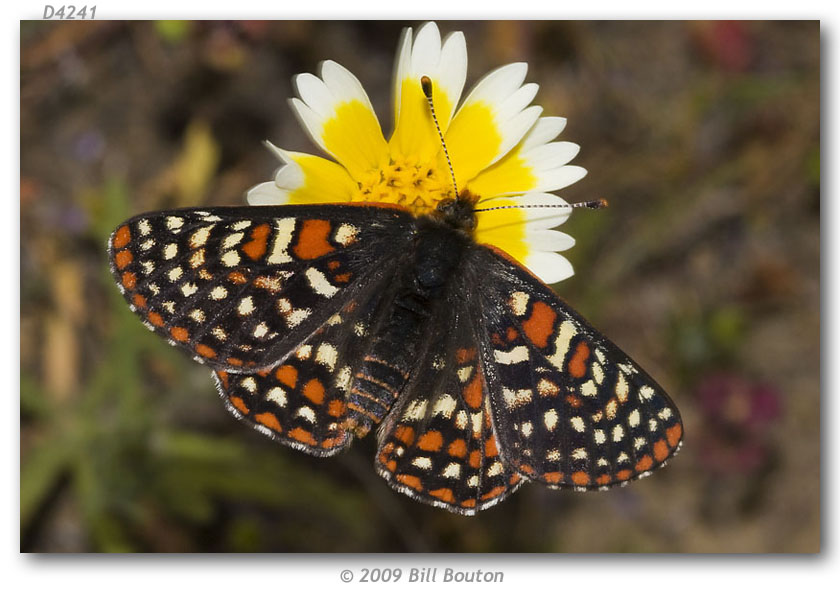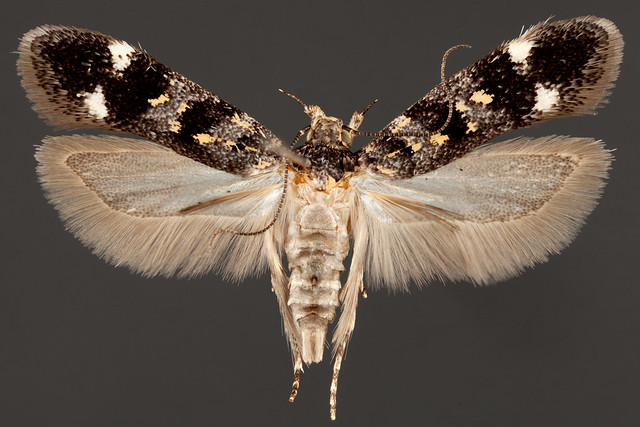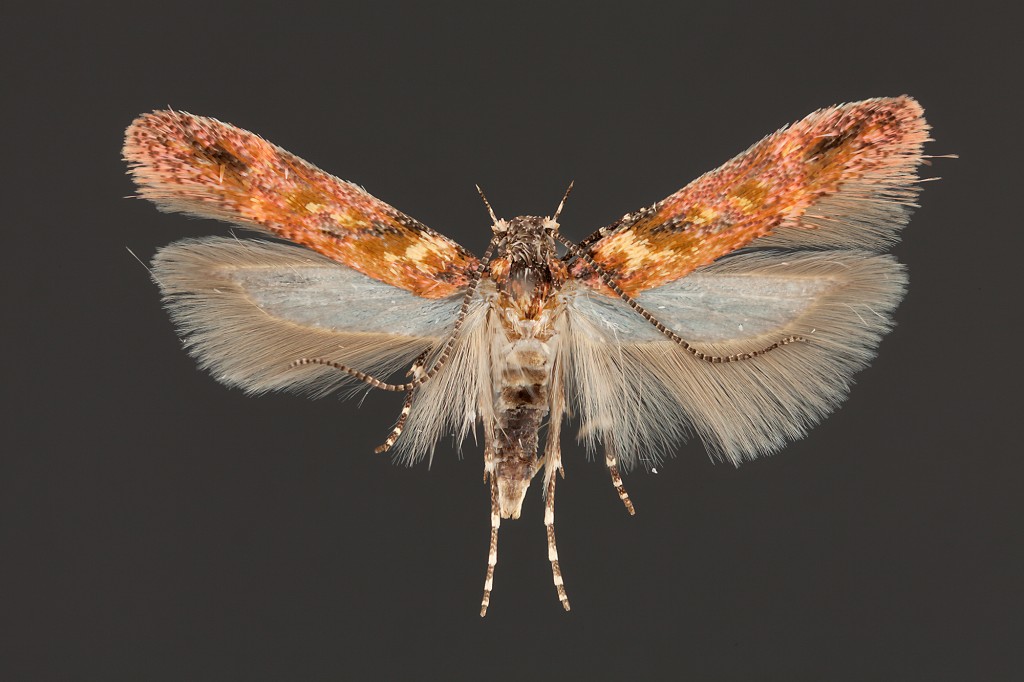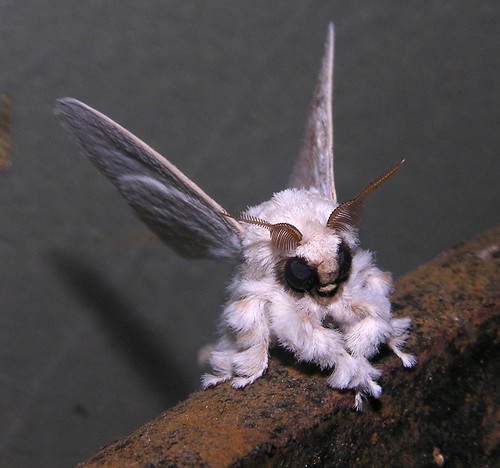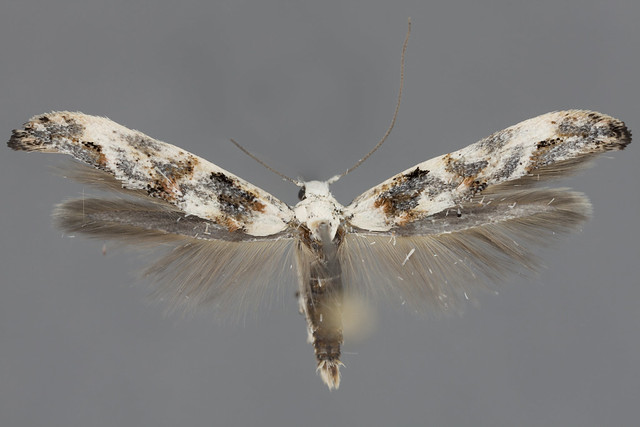Polilla de hoy es una especie hermosa de las Montañas Rocosas fuera de Denver, Stolidota Epermenia (Epermeniidae). Esto es en realidad una muestra de mayor tamaño de lo que parece, aproximadamente 20 mm de ala con ala. Las planteadas, oscurecido, mechones de escamas en el borde posterior del ala anterior es un gran personaje para esta familia, así como las cerdas rígidas sobre la tibia posterior (también algo visible aquí). Hay 11 especies en 2 géneros en los Estados Unidos, con probabilidad un poco más por descubrir. Asistente curatorial compañero David Bettman tecleó esta especie utilizando la revisión de la especie Neártica: PDF aquí.
|
Esta semana estoy compartiendo una pequeña, desaliñado, and semi-competently spread Nepticulidae in the genus Stigmella from the same light trap of Prescott Arizona as the past few Monday Moths. No me suele compartir una foto de una polilla que no está en las mejores condiciones, but I’m using this as an example of technique. Not only was this 4mm moth pulled out of the bottom of a light trap, but it was field pinned and dried for over a year and a half. I’ve always heard that it can nearly be impossible to deal with the smallest of the small; and for the most part I haven’t. I used to think you need to capture them off of a light sheet alive in a vial and euthanize moments before spreading, all while never, ever let them dry the tiniest bit beforehand. But as it turns out, you can get away with a decent specimen by relaxing 24 hours and spreading upside down. Of course if you have a perfectly fresh specimen that avoided the blender of a bucket-trap it would make for a far superior specimen. Better yet, you pulled the leaf mine and reared the moth yourself. Most of these Nepticulidae are host-specific and far more diverse than we have given them credit. I’ve heard there could be at least 100 new species awaiting discovery in the US alone. La historia de muchas mariposas de San Francisco son bien conocidos y deprimente. La zona ha sido fuertemente impactada por el desarrollo humano durante más de dos siglos y es el hogar infame para el primer ejemplo conocido de una mariposa americana extinta, los las Xerces blue. Mientras que otras mariposas están colgando en, or getting help to hang on like the misión azul, some like the Bay Checkerspot have continued to decline despite valiant efforts for reintroduction. Hoy, the only known colony of the Bay Checkerspot is within Santa Clara County on a site called Coyote Ridge. It was twenty one years of intensive study of the checkerspot in the 1960’s and 70’s by the famous biologist Paul Ehrlich that provided the impetus for federal listing in 1987. A partir de 1998 the colonies he studied have since gone extinct. Here is an excerpt from a 1980 paper in the Journal of the Lepidopterists’ Sociedad “Two California Checkerspot Butterfly Species, One New, One on the Verge of Extinction” (.pdf).
All efforts to relocate this butterfly have failed, and the future of this animal is not looking bright. And so what exactly is this creatures name? En 1937 Robert F. Sternitzky described what he thought to be an overlooked San Francisco butterfly “Euphydryas editha var. bayensis“. Those early descriptions of variations and races are roughly equivalent to today’s subspecies – and so the butterfly remained bayensis for decades and became a mascot for conservation. But where was the very first Euphydras editha from and how did the San Francisco bayensis differ? Unfortunately the original description is vague and the collecting locality is simply listed as “California”, as was the unfortunate habit of Boisduval who described the butterfly 1852. But all hope is not lost since the famous French Lepidopterist was having specimens sent to him by the earliest California Lepidopterist, Pierre Joseph Michel Lorquin. An eager gold prospector and butterfly collector, Lorquin traveled California from 1849 a 1858 and again in 1869. Every butterfly that was sent back to France was a new species and subsequently described by Boisduval – who of course named one of California’s most beautiful butterflies after Lorquin. Enter Emmel, Emmel and Mattoon in 1994 who were writing the Systematics of Western North American Butterflies. In the process of cleaning up the mess of these early western species they had to designate a Lectotype for E. editha editha since Boisduval never fixed a Holotype in 1852. Essentially he named a new species without designating the taxonomic standard for the group, making future work ambiguous for taxonomists. Thankfully the travels of Lorquin have roughly been documented and we can ascertain that he should have been in San Francisco around 1849. Comparisons of the original specimens to the Bay Checkerspot made for an overwhelming case that it was this butterfly that was sent to France in the 19th century. The result of this finding therefore places the Bay Checkerspot Euphydryas editha bayensis into synonymy with the older name Euphydryas editha editha. The name bayensis effectively dissappeared because it was a re-description of a butterfly that was already known. Euphydryas e. editha as it turns out has been known from coastal California from the bay region down to San Luis Obispo – and so voila, the range of the Bay Checkerspot just exploded. But of course the story isn’t that simple and the butterfly didn’t become magically safe with a name change. Conservation groups and ecologist kicked and screamed and refused to accept the change, even the Xerces Society hasn’t jumped on board with the consensus of taxonomists out of what I can only assume is fear of the appearance that their butterfly is no longer endangered. I’ll emphasize that this doesn’t mean that the populations in the bay are no longer threatened – there is still a need for protecting these biologically significant populations as they are significantly declining. Habitats all throughout the region are facing ongoing and pernicious threats (pdf). All in all the name change is trivial, we can now call the Edith’s Checkerspot the Bay Checkerspot, and still fight to protect this butterfly. I’m unsure of what would be required to amend the federal register, and if it’s at all possible to expand protection of an animal like this without re-petitioning the endangered species act. So perhaps I can understand the failure to embrace the name change since from the outside it looks like their bug is no longer endangered. Por otra parte, this could bring attention to populations of a butterfly that have been overlooked for decades.
Many thanks to John Pelham for conferring with me over this taxonomic headache.
¿Qué tal otro no identificado Gelechiidae desde la misma ubicación que la muestra anterior (No.. prescott arizona). Estoy intentando que esta polilla esté en el género Chionodos – y es superficialmente similar a la especie do. Seguir. Afortunadamente hay una monografía de este grupo (Polillas de América del Norte de México, fascículo 7.6) y podré diseccionar y, con suerte, llegar a una mejor identificación. Los genitales de las polillas son estructuras maravillosamente esclerotizadas que pueden proporcionar una gran cantidad de caracteres que se utilizan para la identificación.. Tendré que asegurarme de compartir imágenes de cómo se ven los genitales pronto.!
Esta polilla es un buen ejemplo de lo que muchos de mis polillas son en este momento – no identificado! Este es sin duda un Gelechiidae, se puede ver los grandes palpos vueltos hacia arriba en la parte frontal de la cabeza, y una proyección en forma de dedo en las puntas de las alas posteriores. Casi una de las familias más fáciles de microleps para identificar. Y a partir de una gestalt general, tal vez esto es en el Gnorimoschemini? Si alguien reconoce este pequeño individuo por favor hágamelo saber, de lo contrario voy a atacar a la literatura para tratar de localizar el nombre. Esta hermosa polilla es de las montañas fuera de Prescott, EL – Julio 2010. Más bien divertida, hay tantas microlepidópteros que no se identifican fácilmente. Ya ha oído la noticia impactante en cuanto a la cambios inminentes en el Museo Field de Historia Natural en Chicago. En breve, el museo está en crisis financiera y los cambios masivos van a ser implementadas por el nuevo presidente, Richard Lariviere. Es probable que hasta la mitad del personal de investigación (incluyendo curadores titulares) serán despedidos y todos los departamentos de investigación se disolverán en “la ciencia y la educación”. El dinero se gastará la modernización de las exposiciones, a la vez que destripar el núcleo científico del museo. Por favor tome un momento para firmar esta petición y expresar su preocupación: Proteja de Investigación en el Museo FieldHace unos meses, muchos de ustedes probablemente tropezamos con este meme – el famoso Polilla caniche! Y de hecho la mayor parte de la información era un medio decente. Sí, que es real. Sí, es una polilla. Sí, es probable que sea una especie en el Lasiocampidae (posiblemente el género Artace) como correctamente señalado por el Dr.. John Rawlins. Esperaba que todo fuera bien, oye, hay toneladas de polillas lindas por ahí y ya es hora de que alguien se dé cuenta! No me molesté en leer el artículo hasta que un colega me lo envió “Registro cósmico en nbcnews.com“. Lo que encontré fue Sin daño real, pero todo eso de la criptozoología me irrita. Creo que es desafortunado que un criptozoólogo atrapó tanta publicidad y se habló de él con bastante credibilidad.. La criptozoología es no una ciencia, ni lo será nunca. Cuando la criptozoología se lleva a cabo como ciencia, se llama biología. Sí, hay locos por ahí que creen que están conduciendo ciencia real, siguiendo cuentos en círculos y construyendo pilas de anécdotas “evidencia” que nunca parecen dar lugar a verdades. Existen diferencias reales entre lo que hace un científico y un pseudocientífico. Digamos que un científico escucha informes de un extraño animal que vive en las selvas profundas – se embarcan en una expedición (después de pedir financiación) para hacer el trabajo duro de reconstruir historias locales y caminar por las selvas o bucear en los océanos para encontrar los especímenes. Luego traen esos especímenes a casa, diseccionar cada detalle, y publicar los resultados en una revista revisada por pares. Si no se encontraron especímenes, el científico se va a casa con las manos vacías y reconsidera la posibilidad de esta nueva criatura mítica.. Quizás más fondos les daría más tiempo en el campo… (siempre la respuesta, derecho?) Pero la historia termina ahí., sin evidencia el animal no existe. Aquí es donde la criptozoología se aparta de la ciencia real. – aceptan los cuentos anecdóticos como un hecho y nunca admiten la derrota. Nessy existe porque la gente ver él. La explicación no puede ser una gran variedad de opciones más plausibles.… porque el mundo en el que vive un criptozoólogo es mítico y fundamentalmente no es real. Bien suficiente despotricar, esperemos que más polillas adorables lleguen al ciclo de las noticias! Polilla de hoy es un micro impresionante y otra criatura desde el patio trasero de Barb Bartell en las Montañas Rocosas. Que yo sepa, es una especie de mamá (Coleóforidos), probablemente claudia,pero yo no tengo una identificación positiva sobre este insecto todavía. Una vez que comience a buscar en los micros de este sitio, seguramente habrá sorpresas.! |
Escepticismo |
